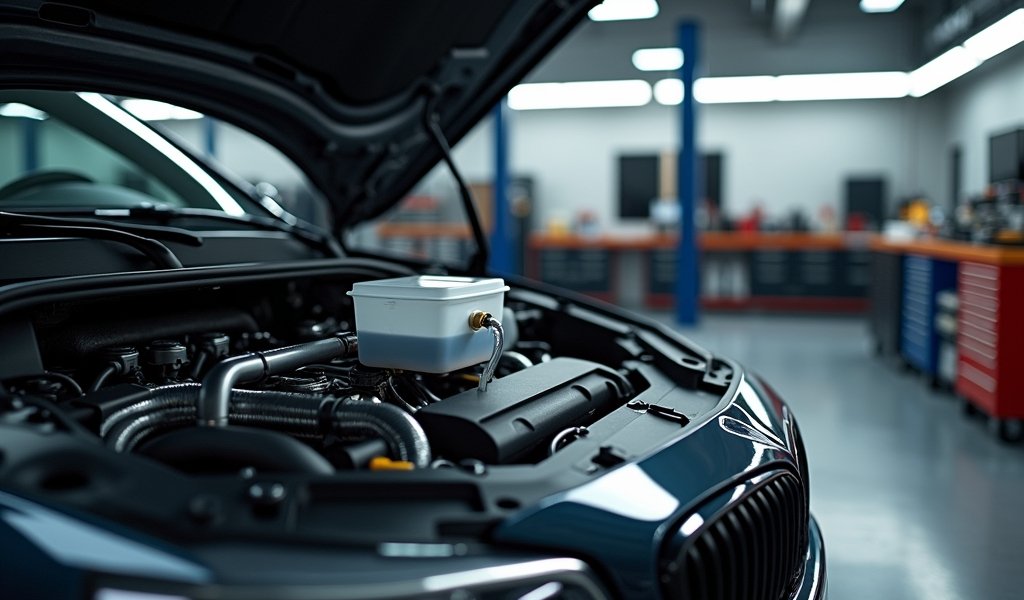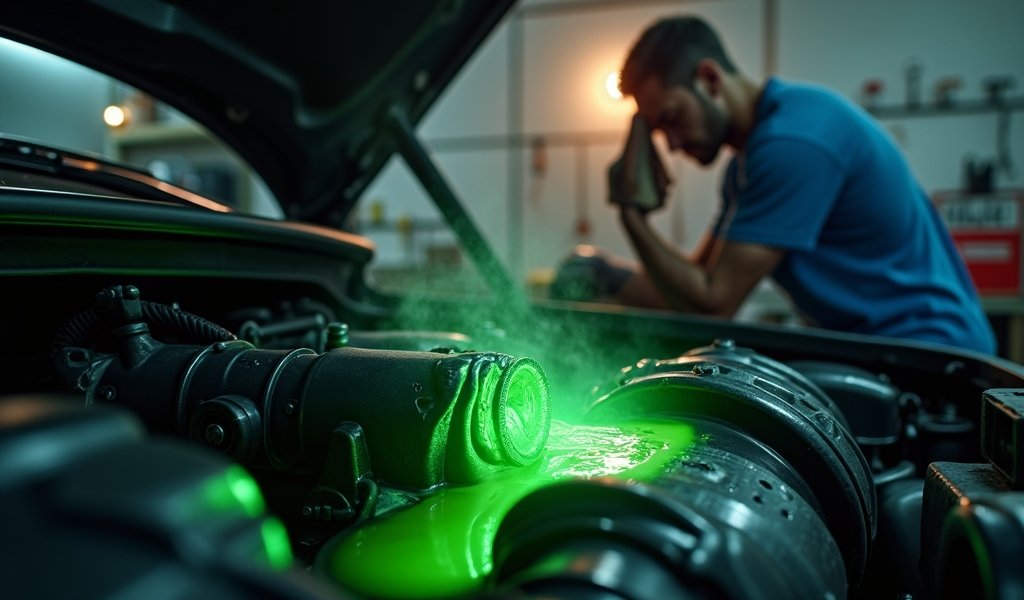Overview
The article explains how the coolant reservoir overflow tube prevents dangerous pressure buildup in a vehicle’s cooling system by allowing excess coolant to escape when the engine heats up. It provides five essential maintenance tips including regular inspection, proper cleaning, correct installation, detecting blockages, and replacement options to help prevent cooling system failures and potential engine damage.
Table of Contents
- What is a Coolant Reservoir Overflow Tube?
- How the Coolant Reservoir Overflow Tube Works
- Common Issues with Coolant Reservoir Overflow Tubes
- Tip 1: Regular Inspection and Maintenance
- Tip 2: Proper Cleaning Techniques
- Tip 3: Correct Installation Procedures
- Tip 4: Detecting and Clearing Blockages
- Tip 5: Replacement Options and Considerations
- DIY vs. Professional Help: When to Call a Mechanic
- Conclusion
- Frequently Asked Questions
When it comes to vehicle maintenance, understanding your car’s cooling system can save you from costly repairs and roadside breakdowns. The coolant reservoir overflow tube is a small but crucial component that helps maintain proper coolant levels and pressure in your engine. In this comprehensive guide, I’ll walk you through everything you need to know about this often-overlooked part, from how it functions to five essential maintenance tips that’ll keep your cooling system in top shape.
What is a Coolant Reservoir Overflow Tube?
The coolant reservoir overflow tube is exactly what its name suggests – a tube connected to your coolant reservoir (also called the expansion tank or recovery tank) that allows excess coolant to escape when pressure builds up in the cooling system. This simple rubber or plastic tube typically runs from the top of the reservoir down toward the ground, positioned to direct any overflow away from critical engine components.
Think of it as your cooling system’s pressure relief valve. As your engine heats up during operation, the coolant expands. Without somewhere for this expanded fluid to go, pressure would build to dangerous levels. The overflow tube provides that escape route, preventing potential damage to hoses, seals, and even the radiator itself.
Most modern vehicles use a closed cooling system, where the overflow tube connects back to the radiator, creating a loop that prevents coolant loss. This design not only protects the environment from coolant leaks but also saves you money by recycling the fluid back into the system once it cools down.
How the Coolant Reservoir Overflow Tube Works
To understand how the coolant reservoir overflow tube functions, let’s follow the coolant’s journey through a typical driving cycle. When you start your car and the engine begins to warm up, the coolant heats and expands. As pressure increases in the radiator, the radiator cap (typically rated for 13-16 psi) allows excess pressure and coolant to flow through a small valve into the overflow tube, which leads to the reservoir.
This process prevents the cooling system from exceeding its pressure limits. Once you turn off your engine and it begins to cool, a vacuum is created in the cooling system. This vacuum draws coolant back from the reservoir into the radiator through a return tube, ensuring proper coolant levels for your next drive.
It’s a brilliantly simple system that operates on basic physics principles – thermal expansion when hot and contraction when cool. The coolant reservoir overflow tube is the unsung hero that makes this process possible, preventing both pressure-related damage and coolant loss.

Common Issues with Coolant Reservoir Overflow Tubes
Despite their simple design, coolant reservoir overflow tubes can develop several problems that might affect your cooling system’s performance. Recognizing these issues early can prevent more serious damage to your engine.
Cracks and deterioration are perhaps the most common problems. Over time, the rubber or plastic material of the tube can become brittle from exposure to heat cycles and engine chemicals. These cracks might be small and hard to spot but can lead to coolant leaks and improper system pressure.
Blockages represent another frequent issue. Debris, mineral buildup from coolant, or even small insects can obstruct the tube. When this happens, pressure can’t escape properly, potentially causing hoses to burst or seals to fail. If you notice your radiator hoses bulging unusually, a blocked overflow tube might be the culprit.
Improper installation after maintenance is also worth mentioning. If the tube isn’t routed correctly or is kinked, it won’t function as designed. I’ve seen plenty of cases where a well-meaning DIYer accidentally pinched the overflow tube while working on something else, creating restrictions that led to cooling problems down the road.
Finally, disconnection can occur, especially after engine work. A loose overflow tube might not seem important, but it can lead to coolant spraying onto hot engine parts or the ground, creating both safety and environmental hazards.
Tip 1: Regular Inspection and Maintenance
The best defense against coolant overflow tube problems is regular inspection. I recommend checking your overflow tube every time you pop the hood – it only takes seconds but can save you significant headaches.
Start by visually examining the entire length of the tube for any cracks, splits, or signs of wear. Pay special attention to bends and connection points where stress concentrates. The tube should be flexible but not overly soft or gummy, which can indicate deterioration.
Next, check the connections at both ends of the tube. At the reservoir end, ensure it’s firmly attached and shows no signs of leakage. If your vehicle has a closed cooling system, also verify the connection at the radiator end is secure.
Make a habit of performing this inspection at least every oil change, or more frequently if you drive in extreme conditions. According to the Car Care Council, cooling system failures are a leading cause of vehicle breakdowns, and many could be prevented with simple inspections.
Remember to perform these checks when the engine is cool. A hot cooling system is pressurized and can cause severe burns if opened or if a component fails during your inspection.
Tip 2: Proper Cleaning Techniques
Keeping your coolant reservoir overflow tube clean ensures proper functioning and extends its lifespan. Cleaning this component requires care to avoid damage while effectively removing deposits and contamination.
Before starting, ensure your engine is completely cool. Disconnect the tube from the reservoir (and radiator if applicable) by gently twisting while pulling. Inspect the inside for any visible blockages or buildup – a flashlight can be helpful here.
For light cleaning, flush the tube with distilled water until it runs clear. For more stubborn deposits, create a cleaning solution of equal parts distilled white vinegar and water. Fill the tube with this solution, cap both ends (your fingers work fine), and gently shake. Let it sit for 15-20 minutes before rinsing thoroughly with distilled water.
Never use harsh chemicals or tools like wire brushes that could damage the tube’s interior. For extremely dirty tubes, sometimes replacement is the better option – they’re typically inexpensive and worth the peace of mind.
After cleaning, blow compressed air through the tube (if available) to remove any remaining moisture before reinstallation. This prevents water droplets from diluting your coolant.
While you have the tube disconnected, it’s a perfect opportunity to inspect the connection points on both the reservoir and radiator (if applicable). Clean these as well to ensure a proper seal when you reinstall the tube.

Tip 3: Correct Installation Procedures
Proper installation of your coolant reservoir overflow tube is crucial for the effective operation of your cooling system. Whether you’re replacing an old tube or reinstalling after cleaning, following the correct procedure prevents future problems.
Start by ensuring you have the correct replacement tube if installing a new one. While they may look similar, overflow tubes can vary in diameter and length depending on your vehicle model. Using the wrong size can result in poor fit and potential leaks.
When routing the tube, follow the original path as closely as possible. Avoid sharp bends or placing the tube near moving parts or extreme heat sources like exhaust manifolds. The tube should have a gentle downward slope from the reservoir to allow gravity to assist the flow of excess coolant.
For connection points, ensure a snug fit by pushing the tube firmly onto the nipple or fitting until it’s fully seated. If your vehicle uses clamps to secure the connections, don’t overtighten them – you want to secure the tube without crushing it. A good rule of thumb is to tighten until you feel resistance, then about a quarter-turn more.
After installation, verify that the tube’s exit point is positioned to direct any overflow safely away from electrical components and belts. In closed systems, double-check that the return connection to the radiator is secure.
Finally, start your engine and let it reach operating temperature while watching for any leaks around the newly installed tube. If everything stays dry, you’ve done the job correctly.
Tip 4: Detecting and Clearing Blockages
Blockages in the coolant reservoir overflow tube can cause serious problems, from coolant loss to potential engine overheating causes. Detecting these obstructions early can save you from expensive repairs.
The most obvious sign of a blockage is coolant overflow from the reservoir cap rather than through the tube. If you notice coolant spilling from the top of the reservoir when the engine gets hot, there’s a good chance your overflow tube is obstructed. Other indicators include unusual pressure in the cooling system, bulging hoses, or coolant leaks from other components as pressure seeks alternative escape routes.
To check for blockages, visually inspect the tube for any kinks or pinch points first. Sometimes the solution is as simple as repositioning the tube. If the external appearance looks normal, try blowing gently through the tube (after disconnecting it from the reservoir). If you meet resistance, you’ve found your problem.
Clearing minor blockages can often be accomplished using the cleaning methods discussed earlier. For stubborn obstructions, try using a pipe cleaner or soft bottle brush that won’t damage the tube’s interior. Never use metal wires or high-pressure air that could puncture the tube.
If these methods don’t work, or if the tube appears damaged during your blockage-clearing attempts, replacement is the safest option. According to NHTSA data, cooling system failures contribute to numerous vehicle fires annually, making this small maintenance task particularly important for safety.
Tip 5: Replacement Options and Considerations
When the time comes to replace your coolant reservoir overflow tube, you have several options to consider. Making the right choice ensures optimal performance and longevity of your cooling system.
OEM (Original Equipment Manufacturer) tubes are designed specifically for your vehicle model. While typically more expensive, they offer the best fit and material compatibility with your cooling system. If your vehicle is relatively new or you plan to keep it long-term, OEM parts are often worth the extra cost.
Aftermarket tubes provide a more economical option and are widely available at auto parts stores. Quality can vary significantly, so look for tubes made from EPDM (Ethylene Propylene Diene Monomer) rubber, which offers excellent heat and chemical resistance. Silicone tubes cost more but provide superior durability in extreme temperatures.
Universal tubes can be purchased by the foot and cut to length. These work well in a pinch but require careful measurement and may not match the original diameter perfectly. If choosing this route, select a tube with slightly thicker walls than the original for better durability.
When purchasing a replacement, bring your old tube to ensure proper matching of both diameter and length. Most overflow tubes use standard sizes (typically 1/4″ to 3/8″ inner diameter), but confirming the exact specifications for your vehicle prevents frustrating fit issues.
Consider upgrading to higher-quality materials if you operate your vehicle in extreme conditions. For instance, research published by the Society of Automotive Engineers shows that high-silicone content tubes can last up to three times longer than standard rubber in high-temperature environments.
DIY vs. Professional Help: When to Call a Mechanic
Replacing or maintaining your coolant reservoir overflow tube is generally a straightforward DIY job, but there are situations where professional assistance makes more sense.
Consider handling it yourself if you’re comfortable with basic vehicle maintenance and have easy access to the overflow tube. Most replacements require no special tools and can be completed in 15-30 minutes. This is also true for routine cleaning and inspection – simple tasks that any car owner can master with minimal practice.
However, call a professional if accessing the overflow tube requires removing other components. In some modern vehicles with cramped engine compartments, what should be a simple task can become surprisingly complex. A mechanic has both the tools and experience to navigate these challenges efficiently.
Professional help is also advisable if you notice symptoms beyond just the overflow tube issue. If you’re experiencing persistent overheating, coolant loss, or engine performance problems, these could indicate more serious cooling system issues that a qualified technician should diagnose.
If you’re uncomfortable working with coolant (which is toxic and requires proper disposal), a professional can ensure environmental compliance. Many service centers recycle used coolant, making them the environmentally responsible choice if you need to drain the system.
Whether DIY or professional, address overflow tube issues promptly. This small component plays an outsized role in protecting your engine from potentially catastrophic overheating damage.
Conclusion
The coolant reservoir overflow tube may be one of the simplest components in your vehicle’s cooling system, but its importance shouldn’t be underestimated. This humble rubber tube prevents pressure buildup, manages coolant expansion, and helps maintain proper fluid levels – all critical functions for your engine’s health and longevity.
By following the five tips outlined in this guide – regular inspection, proper cleaning, correct installation, detecting blockages, and making informed replacement choices – you can ensure this component continues performing its vital role. These simple maintenance tasks require minimal time and expense but can prevent costly cooling system failures down the road.
Remember that cooling system maintenance is a holistic process. While focusing on the overflow tube, also keep an eye on related components like the radiator cap, hoses, and the reservoir itself. A cooling system is only as strong as its weakest link.
Whether you’re a DIY enthusiast or prefer professional service, understanding the function and maintenance of your coolant reservoir overflow tube empowers you to make informed decisions about your vehicle’s care. After all, knowledge is the best tool in any car owner’s toolkit.
Frequently Asked Questions
What happens if the coolant reservoir overflow tube is clogged?
A clogged overflow tube prevents pressure release, potentially causing hoses to burst or seals to fail. This pressure buildup can lead to coolant leaks, overheating, and possible engine damage.
How often should I replace my coolant reservoir overflow tube?
Replace your overflow tube every 5-7 years or whenever you notice cracks, stiffness, or deterioration. Environmental factors and driving conditions can accelerate wear, so regular visual inspections are important.
Can I drive with a damaged coolant overflow tube?
Driving with a damaged overflow tube is risky and not recommended. It can lead to coolant loss, improper cooling system pressure, and potential overheating that may cause severe engine damage.
Where does the coolant overflow tube drain to?
In older vehicles, the tube typically drains to the ground beneath the car. Modern vehicles often use a closed system where the tube connects back to the radiator to recycle the coolant when the engine cools.
Is coolant coming out of the overflow tube normal?
A few drops during temperature changes is normal, especially after filling the system. However, continuous or substantial leakage indicates a problem such as overfilling, a faulty radiator cap, or cooling system issues that require attention.

